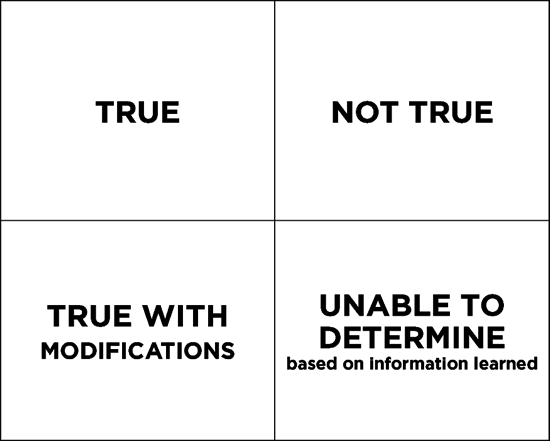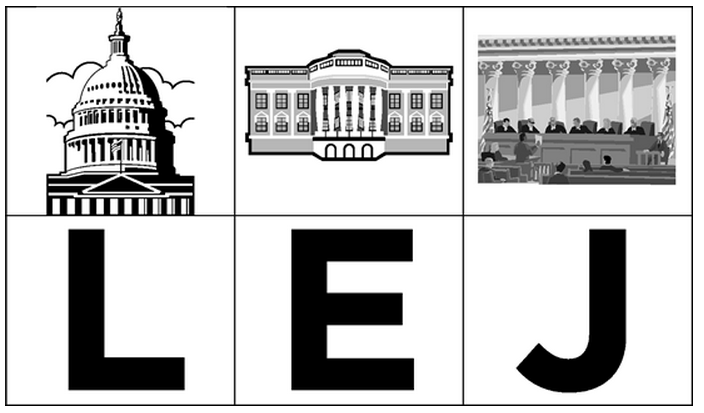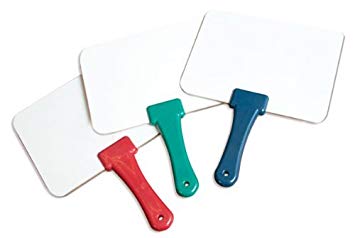Hold-Ups
What It Is
Hold-Ups are interaction-based activities that use response cards. In these activities, students interactively reflect on a prompt and hold up a card, paper, or whiteboard in response. The most essential component to the Hold-Up is the interaction. Students learn a great deal from each other through their interactions. When students hold up different cards, help them use it as a thinking activity for the groups. Let the students explain their thinking to each other, and then do another vote. If students express blatant misconceptions, then insert a quick minilesson before doing the second vote.
Be careful not to shoot down student ideas. Often you can help students come to alternate conclusions with a simple statement such as “Tell me more” or a gentle question such as “I see where you are going with that, but is that always true?”
For your classroom to be conductive to using Hold-Ups, students need to feel safe taking risks. So be sure to validate students through the words you use as well as your facial expressions and body language. It helps students understand that discussion and critical analysis are part of the journey in learning.
How It Works
- Ask the students to think about or jot down their thoughts about a set of prepared questions.
- Before students hold up their cards, have them Pair-Share of confer in small groups.
- Say “Hold It Up.”
- Students hold up the card of their choice. Select students to share their group’s rationale for their choice.
Depending on the activity, you can modify this by asking students to hold up their cards before they meet in pairs or small groups. Let students know at what point you’d like them to hold up their cards.
You can combine a Hold-Up with the Numbered Heads Together strategy to keep all students accountable. For example, you might say, “I would like person #3 to explain why your team chose that response.”
How to Ensure Higher-Order Thinking
Move away from simply looking for the right answer. Use wrong answers as teachable moments, and try your best not to provide quick answers for students who hold up the wrong card. Instead, provide students with an opportunity to explain their thinking, hear opposing responses, and come to their own conclusions through a re-vote If students are still not understanding, then use that opportunity to reteach the concept while the students are invested in knowing what the right answer should be.
It is important that you intentionally create and embed questions requiring higher-order thinking in your Hold-Ups. Use questions that require students to analyze and make connections between the various components inherent in the concepts you are teaching. Use questions that have no easy answers. Get students used to defending their responses, especially those that require higher-order thinking.

Source
Himmele P., and Himmele, W. Total Participation Techniques: Making Every Student an Active Learner. ASCD, 2017, pp.60-69.
Variations
Selected-Response Hold-Ups
These Hold-Ups use a selection of relevant choices that are prepared beforehand. Students hold up cards as they relate to specific prompts or questions.

Number Card Hold-Ups
If you teach math, consider providing students with one to three decks of number cards (0-9). Number Card Hold-Ups offer an added bonus in providing students with increased exposure to vocabulary specific to mathematics (for example, “Hold Up the least common multiple of 6 and 3.”).
True/Not True Hold-Ups
These can be used within all content areas. Again, it allows students to interact and come to a consensus on whether a content-based statement is True, Not True, True with Modifications, or whether students are unable to determine the truth using what they have learned so far.
Consider using predictions or students’ own True/False statements as the basis for these Hold-Ups. Because very few things in life are completely right or completely wrong, many responses actually end up being True with Modifications – especially in Social Studies, where history is subject to historians’ personal perspective. For example, consider the following prompt, “The American Revolution was caused by British taxation of the Colonists.” Students really have to think about that statement. Is there a way to make it “more true”? By thinking through peers’ proposed exceptions, students start anticipating and thinking through exceptions, and they take into account the subjectivity of perspective. When appropriate, students can edit the statements in groups, so that the statements clearly fir into the True category.
You can also have students write statements on sticky notes to be attached to a chart paper or large whiteboard divided into four quadrants, labeled True, Not True, True with Modifications, or Unable to Determine. As the class votes, the sticky notes can be placed in the corresponding areas on the graphic. Any sticky notes that go in the True with Modifications quadrant can be edited by students to so that they are made true. As you continue your unit, you can revisit the statements days later, reviewing what was learned or checking to see if students still agree with the statements’ placement in the quadrants. The statements that were placed in the Unable to Determine quadrant can be revisited as students learn new information.
Multiple Choice Hold-Ups
This simple Hold-Up option requires that you create and project questions onto a screen. Students make a choice, confer with their peers, and at your signal hold up their choice A, B, C, or D. The letters are assigned to specific options written on the board. The letter cards can be used over and over again because the options will change with each topic you are presenting.
What is different about Multiple Choice Hold-Ups compared with a worksheet or multiple-choice test is that you can create questions that require students to apply a skill or come to different conclusions and still be right, For example, “Which would you say would be the most practical unit ti use in measuring your pet?” The most practical unit depends on the pet. Students can also analyze, come to different conclusions and still be right based on their own rationales. For example, “Which of these government systems would you say leads to a more peaceful society?” The answer depends on how each student defines a “peaceful society” and the examples used to defend the choice.
Multiple Choice Hold-Ups can also work well when you want to do impromptu Selected-Response Hold-Ups. You can simply assign response choices to letters and write them on the board so that students don’t forget the letters assigned to each option.
Whiteboard Hold-Ups
The benefit of using Whiteboards for Hold-Ups is that the possibilities for choices of response are much wider. Students can record their thoughts, draw a diagram, solve a math problem, etc., and then hold up their whiteboards for analysis by the teacher.
If you don’t have whiteboards in your classroom, you can easily create your own by laminating a light-colored sheet of construction paper. Another creative way of making your own whiteboards is to purchase white plastic disposable plates, which also allow for easy removal of answers written with dry-erase markers. Another option is to purchase large markerboard at a home improvement store and have it cut into smaller pieces to make a class set of individual whiteboards.

